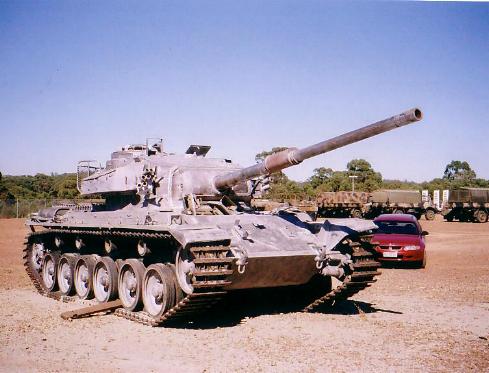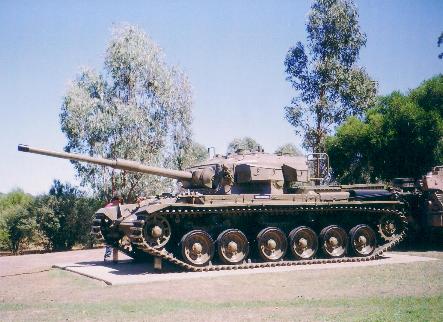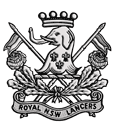PAGE 1
Looking Back
At this point of time, the
information and stories and found Centurions have slowed a bit, but they have by
no means stopped. So I have decided to go back over my CD’s and list some
information from them, as my Web Site was started after the CD’s were
finished. As people who have been following my efforts will know there is no
order, no index and I have been known to repeat myself. This effort will be no
different. I know before I start that I will repeat some items / photos. But to
be honest I am now at the stage where I am not sure if something was in my web
site or my CD’s. Anyway who cares, it’s all free! I hope there are people
out there that enjoy my little effort. Once again I will state I am no
historian, I do the best I can and that I am afraid is it!!!
Centurion
Main Battle Tank
•
The Australian Army was the first purchaser of the Centurion tank out
side of the U.K. They first ordered it in 1949.
•
It was not until the September 1951 that the Australian Army finally
received it’s first Centurion tanks. These first two tanks were given to
Armoured Centre and the next few went to1st Armoured Regiment. The
first tanks to arrive in Australia were Centurion Mk 3, equipped with 20 pounder
guns and Besa machine guns. These machine guns were soon replaced, by American
.30 calibre Browning’s. This changed the designation of the tank from Mk3 to a
Mk5
•
The Centurion coped well with the Hostile environment of Australia as
the Horstman suspension reacted well and reliably. Unlike the Leopard, which
goes through spare parts at an alarming rate.
•
Altogether the Australian Centurion fleet comprised a total of 143
Centurion tanks (Army Registration Numbers (ARN) 169000 - 169138, 115541 -
115544) at its peak between 1972 - 77. This consisted of: -
•
60 Mk.3 medium tanks purchased in 1949 and delivered from September 1951
and were still being delivered after August 1952 were subsequently upgraded to
Mk. 5 standard between 1957 and 1961. (ARN 169000 - 169059)
•
51 MK. 5 medium tanks purchased in late 1954 and delivered during 1955 -
56. (ARN 169060 - 169110)
•
4 Armoured Recovery Vehicles (ARV) Mk. 2 ordered in late 1954 and
delivered in 1955 - 56. (ARN 169111 - 169114)
•
6 Mk. 5 medium tanks delivered in 1956- 57 (ARN 169115 - 169120)
•
4 Bridge Layer Mk. 5 delivered in early 1960’s, the first arriving in
September 1961. (ARN 115541 - 115544)
•
8 Mk5 and Mk5/1 medium tanks were purchased from New Zealand during
1968. The medium tanks were cannibalised for spares, and while the ARV was taken
into service, it only served in Australia. (ARN 169123) A small number of New
Zealand hulls were used to replace mine damaged hulls and at least one tank, ARN
169017, returned to South Vietnam for a second tour fitted with a New Zealand
hull.
•
15 Mk5/1 medium tanks purchased from UK stock held in Hong Kong arriving
in 1972 (ARN 169124 - 169138).
•
Some of the damaged tanks returning from Vietnam were converted to
Driver Training Vehicles by removing the turret and installing a superstructure
with large windows and seats for the instructor and trainees. These vehicles
were used to train drivers from 1974 until 1977. With out the weight of the
turret these vehicles rode much higher than the gun tanks. The Centurion was
eventually, phased out of service in the Australian Army in 1977, to be replaced
by the German Leopard tank. Not all the Driver training tanks were ex Vietnam
tanks.
•
The Dozer tank was to assist in the mobility of the Armoured Vehicles in
Vietnam. It could dig firing positions and minor earth moving tasks. The blade
was made in Newcastle UK by T B Pearsons It had a cutting edge and a hinged flap
on top for scooping earth. The blade was hydraulically operated from the
driver’s seat, with power coming from a main engine.
•
The Prototype Bridge Layer was first built in 1956, but it was not until
1961 that the vehicle went into full production in the U.K. The Australian Army
received their four Bridge Layers in 1965. They were built on Mk5 chassis
reworked to Mk7 standard. They were without a turret the resulting hole was
plated over. The 100-gallon fuel tank was fitted as standard. The No. 6 tank
bridge was constructed of Aluminium alloy and could carry a load of 80 tons over
a gap of 13.5 metres. Two of these vehicles saw service in South Vietnam.
•
The ARV MK.1 was based on the Centurion Mk.1 and Mk.2 chassis with the
turret removed and a slab sided superstructure added. This superstructure housed
the winching mechanism. This winch had an 18 Ton pull. An earth spade was fitted
to the rear of the vehicle this was found to be inadequate and was often
reinforced in active service. A set of Hollebone drawbars, were provided for the
towing of tank casualties. Crew access was by tow hatches on the roof. This is
the only Mk.1 to be used in Australian service and was purchased from New
Zealand in 1969.
•
The ARV Mk.2 first entered service with the Australian Army in 1956.
This vehicle was very much different from the Mk.1. The earth anchor was much
improved and the winch had a greater pull, of 30 tonnes. Up to 90 tonnes could
be achieved with a 3 to 1 tackle layout. Two of these vehicles served in South
Vietnam form 1968 until 1971. There were in fact, 4 ARV’s in Vietnam, but only
two at any one time
•
Vietnam
•
Prior to deployment to South Vietnam the tank fleet comprised 117
Centurions. Of these 96 were Mk. 5/1 and 25 were Mk. 5. The Mk 5’s were for
training purposes only. All medium tanks were being progressively fitted with
the .50 cal Ranging machine gun, and 100 - gallon long-range fuel tank.
•
26 Mk. 5/1 were being fitted with the complete UK infrared installation
and another 3 were fitted with the appropriate brackets etc. but not the
complete installation. While 4 Centurion Mk. 5/1 medium tanks (ARN 169071,
169078, 169079 and 169106) were converted to tank dozers commencing in the mid
1960’s.
Centurions were issued from 1 Central Ordnance Depot (1 COD), located at
Bandiana. Where they required additional modifications to be added to bring them
up to the latest prescribed standard. They were sent to 4 Base Workshop, also
located at Bandiana. This was the standard issuing system.
•
On 17th October 1967 the Australian Government announced that
a tank squadron would be dispatched to South Vietnam as part of wider troop
increases.
These were
o
C Squadron, 1st Armoured Regiment (Reinforced tank squadron).
18 Mk. 5/1 medium tanks
2 tank dozers.
2 Bridge Layers
o
1st
Independent Armoured Workshop (RAEME)
2 ARV Mk. 2.
o
Detachment, Forward Delivery Troop 1st Armoured Regiment
6 Mk. 5/1 medium tanks.
•
The tank squadron was operational in South Vietnam from 29th
January 1968 to 30th September 1971.
Squadron names changed on approximately a12 month basis, but this was only an
administrative and command change. Unlike the infantry battalions that rotated
as complete units the RAAC operated an individual replacement system due to
insufficient numbers in the Corps.
•
Centurions
not returned to Australia due to battle damage served a tour of 2500 track miles
after which they were declared “Beyond Local Repair” and returned to
Australia. Replacement vehicles were transferred from the forward delivery
troop. New vehicles were issued from 1 COD and shipped to South Vietnam where
they were issued to forward delivery troop.
51 centurion medium tanks, 4 ARV’s and 3 Bridge
Layers served in South Vietnam. A small number of tanks and ARV’s served
twice.
Information
Courtesy of Shane Lovell – Bruce Cameron – Mike Cecil Curator of Military
Technology, Australian War Memorial
I
do get a lot of help
CALL
SIGNS AND SERIAL
NUMBERS:
All Centurions were given an
Australian Serial Number In the case of Gun Tanks and ARV’s these all started
with the number 169. In the case of bridge layers they had 115541, 115542,
115543, 115544.
The serial
numbers started from 169000 up to 169138
These numbers stayed with the tank
for its lifetime and even in the case the hull was replaced it still carried the
old hulls number. Some confusion rose with 169080, which had a new hull fitted
and retained the old number as it should. But much later the OLD hull was
restored as a museum piece due to its history and has no number on it, but then
the old paint was removed and both the Australian and the British number were
seen, people claimed it was169080. Which it was indeed, but the other 169080
also has the right to hold the serial number.
Call signs were also misleading, as
I found out. Having a list, of the call signs and the dates they were used in
Vietnam and also the serial numbers and time they were in country, I thought I
could identify from photos. Alas this was not to be in all cases, unless the
date was with the photo. The crew commander had the call sign and when he moved
tanks for many reasons he just took his call sign plate and hung it on his next
tank. The only thing wrong with this is that it gave me headaches. There were
even cases where the rest of the crew mistakenly referred to the incorrect tank
serial numbers.
So I will try and stick with serial
numbers.
At the age of 65 years I suppose we
all start to look back a bit. One day I decided to drive to Puckapunyal, which
is not all that far away from my home at Kilmore, about half an hours drive. My
first view on arriving at Puckapunyal was to see civilians manning the Security
Gate. They were very polite and very business like. Obtaining a pass, my first
sight was a Centurion holding ground, just inside the entrance. This was my
first Centurion seen in 44 years, and I stopped and had a walk around it.
The name “Bewildered” on the
side bins and the number 169031 stood out on the front glacis plate. I wanted so
much to climb onto the guard and open the driver’s hatch, but it was made
quite clear that this was not to be. There was something different about 031 and
I noticed that the main gun was different. It had been fitted with the 105 mm
which was the gun fitted to the new Leopard Tank. As the barrel took the whole
of the case and projectile, there was no need to change the breach block or make
other modifications. Basically just screw on another barrel and it was modified.
This was the only one that I found with this configuration.
At a much later date I discovered that this had been a
Centurion converted to a Drivers instruction tank and the turret had been
removed. It was later still I learnt it had been consigned to the gunnery range
as a hard target. It was rescued from this situation, and a turret refitted. But
there were no barrels available, so a 105 mm from a Leopard was installed. So
the difference! Just to hand is information that Bewildered is to be repainted
and cleaned up, Great news. It took about 12 months but it was in time restored,
a process I watched from start to finish.

Ready for the new paint job she was a sorry sight

Sandblasted
and ready for her paint job

Splendid in her new colours
The main idea behind
this C.D. was to locate and photograph as many surviving Centurions as it was
possible to find.
It was my hope that I
could see around 15 – 20, and as this was to be for my own use only, there was
not much thought put into it, just a photo and a bit of text below it stating
anything of interest or history of each Centurion I found.
It
was soon apparent that I was going to uncover more than my original estimate. I
also started to notice differences in the modifications, and configurations that
I was finding. This started an interest to know more, and the thought occurred
that maybe others would be interested in these items of interest as well, and
the whole agenda started to snowball.
Below
is what started it all. This was
the Centurion I drove back in the early 50’s and I had a desire to see it
again.


Here
are two pages from a UK magazine The top one is 169007 named "Buka Boom Boom" and
carrying the call sign 22A
Its
pretty exact except the call sign was 24A.
This mistake was later explained. When 169007 was returned to Australia it was
replaced with 169067 and the name was repainted onto her barrel but it was BUKA BOOM BOOM 11
and its call sign was 22A.
But as the tank above has the Serial No 169007 it was in fact
24A
 The name on 169007
The name on 169007
 The name on 169067
The name on 169067
ANYWAY
It all started at Puckapunyal.

As you enter Puckapunyal

169031
“BEWILDERED”
HOLDING GROUND
AT THE ENTRANCE TO PUCKAPUNYAL
By this time I
was all fired up and my desire was two fold. To get inside a centurion with my
camera and to sit in the drivers seat again. This, after a lot of knock backs
from just about everyone, was finally achieved with the kind assistance of the
Vietnam Veterans Museum at San Remo Victoria. And a lasting friendship started
with both the Museum and many many Veterans.
It very quickly
became apparent that I was going to drive a Cent again before I passed away.
Just how this was to be achieved I had no idea. Never in my wildest dreams did I
imagine I would be driving most of the running Centurions in Australia over the
next three years.
But I am
getting ahead of myself. I quickly worked out that I needed a Centurion that was
running and located somewhere that there was enough room to have a decent drive,
although 100 yards would have been ok with me.

Lt. Col Peter
Jarratt (RETD) was kind enough to give me the opportunity to drive his tank
169005 on his property in NSW. After 40 years I dropped down into the drivers
seat and was quite terrified. The drive went great, I missed a gear early on but
that was it. I had a great drive over many miles and cut up Peter’s property a
fair bit. The hardest part was remembering the hand signals in reverse, the
opposite to what was expected, but even that came back quickly. My confidence
was booming. After leaving Peter we drove to Holbrook and viewed the Tanks on
Vince Ryan’s property that was a storage yard for Tim Vibert the chap that
brought the lot from the army.

This lot in the shed are in two rows you
cannot see the rear row and that is only two thirds of the shed

But that is what the inside of the shed
looked like

I was having a ball, like a kid in a
lolly shop

These four are in the paddock at the rear
and classed as "Old Smokies"

There are ten in the group of "Old
Smokies" they have now gone to the scrap metal yards and been cut up
I was hoping
that this would quieten down my burning desire but instead it inflamed it
 169078 The Dozer
169078 The Dozer
 and a Bridge Layer and an ARV
and a Bridge Layer and an ARV
Following up a
lead we called into Wangaratta on the way home and there found three more. A
Bridge Layer, a Dozer and an ARV above. These three have now been moved to a
property outside Wangaratta.
+






 The name on 169007
The name on 169007  The name on 169067
The name on 169067







 169078 The Dozer
169078 The Dozer and a Bridge Layer and an ARV
and a Bridge Layer and an ARV